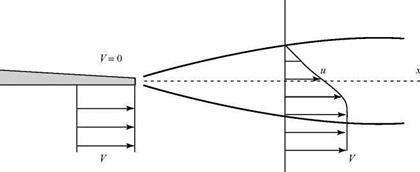Free-Shear Layers, Wakes, and Jets
Space limitations do not permit a detailed discussion of these topics. The interested student is referred to the book by Schlicting, 2003. The following discussion describes the physical phenomena of interest and introduces terminology. Only twodimensional flows of this type are presented.
Free-Shear Layers
A free-shear layer is a viscous flow bounded on one side by a uniform flow and on the other side by a fluid at rest. Consider, for example, a viscous flow coming off
|
Figure 8.26. Free-shear layer. |
the lower surface of a plate with zero-velocity flow above (Fig. 8.26). For simplicity, assume that the boundary layer on the plate surface is negligibly thin.
The shearing action tends to pull along some of the fluid at rest and retard some of the fluid coming from the plate surface; the result is a velocity profile as shown. The nonuniform portion of this profile becomes wider with increasing x. A twodimensional free jet (i. e., slot jet) has a velocity profile (as in Fig. 8.26) on either side of the jet as it emerges into still air. A short distance downstream of the exit, the two profiles merge to form a rounded-jet profile near the center (as in the case of a jet).












